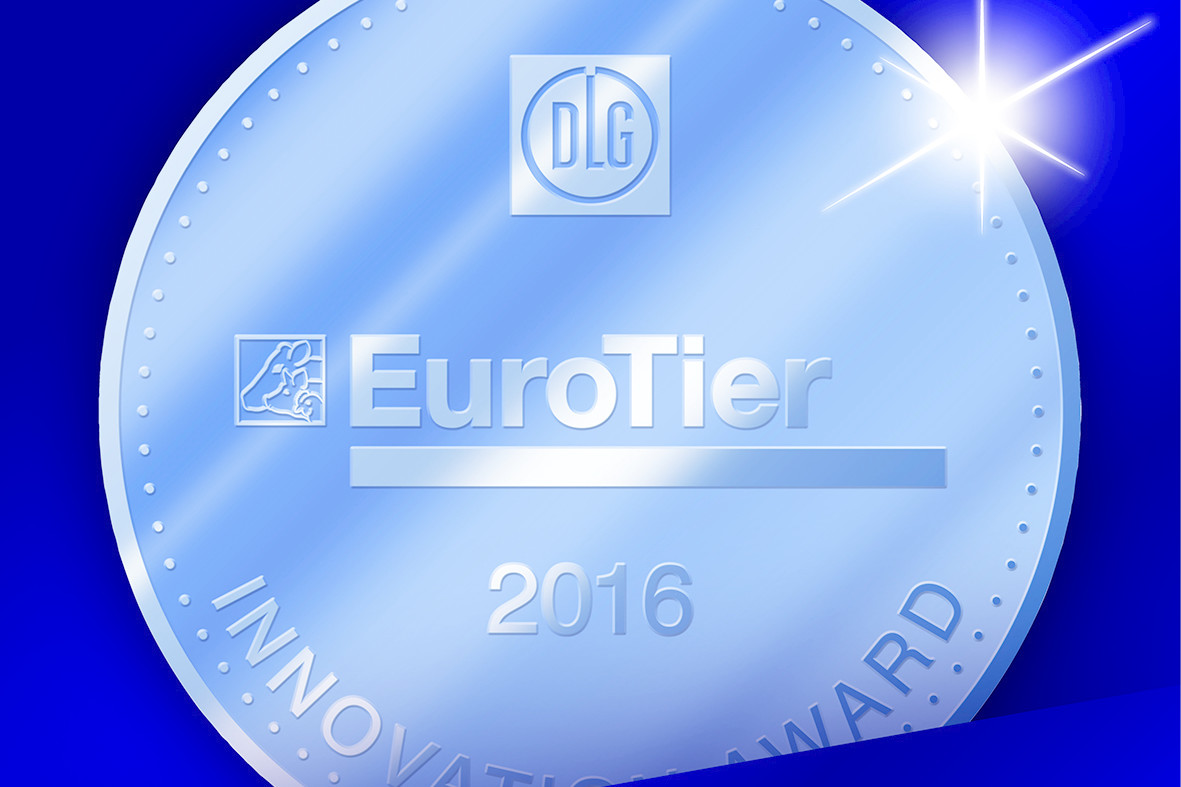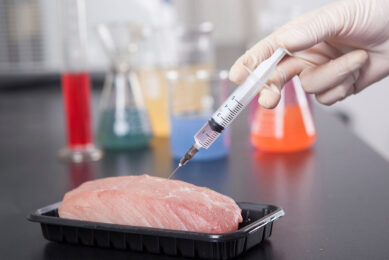Feed innovations awarded at EuroTier

An independent expert committee appointed by the DLG (German Agricultural Society) determined the winners of the Innovation Award EuroTier from among 251 approved applications for product innovations, based on stringent criteria.
The Innovation Award EuroTier 2016 in gold or silver has been awarded to 25 product innovations including some products tailored specifically for the feed sector.
The award level, i.e. gold or silver, will be announced at the official ceremony, which will be held in conjunction with the formal opening of the EuroTier trade fair on 14 November 2016. The trade fair will for the first time be launched on the day before it opens its doors to visitors on 15 November.
Animal feed related winners of the Innovation Award EuroTier 2016 are:
Poultry Star, Biomin GmbH, Getzersdorf, Austria
Establishing and stabilising a healthy intestinal flora is an essential aspect of animal health in poultry farming. Poultry Star verifiably supports these important objectives both during the initial intestinal colonisation just after chicks hatch and as part of successful re-colonisation, for example after a course of antibiotics. Poultry Star is a feed supplement specially developed for poultry on the basis of a host-specific multi-strain synbiotic that promotes early intestinal colonisation and a healthy intestinal flora. The product’s effectiveness is based on the combined use of carefully selected probiotic microorganisms and prebiotic fructooligosaccharides.
This combination is able to increase the resilience of day-old chicks and poultry of any age to pathogenic microbes. It optimises the microbial colonisation of birds’ intestines and improves both overall immunity and performance parameters such as weight gain and feed efficiency. The product received EU approval as an intestinal flora stabiliser in 2015. It is available in two formulations for use in mixed feeds and administration via drinking water.
Smart Calf System, Förster-Technik, Engen, Germany
Changes in drinking patterns and reduced fluid intake are usually the first signs of disease in calves and often occur before any other visually identifiable symptoms develop. However, it is generally difficult to detect changes in behaviour and reduced volumes of fluid intake, especially on larger farms or with changing staff. Also, trying to locate a particular calf in a large area constitutes an additional challenge. The Smart Calf System by Förster-Technik delivers a comprehensive range of modules for monitoring calves both continuously throughout the day and directly as they take in milk feeds or water. The system also supports the electronic location of calves. The Smart Calf System comprises the modules Smart Drink Station, Smart Neckband and Smart Water Station.

It collects important data for monitoring calf health directly from animals, including data on activity and butting behaviour on the teat. As a first, the system incorporates a workflow module with LED display on the Smart Neckband, which facilitates the quick location of animals for monitoring. Actions performed on calves can then be confirmed via a sturdy feedback switch directly on the Smart Neckband and fed back to the higher-level management system. This delivers substantial improvements of the overall system. The Smart Water Station, the third module of the Smart Calf System, allows the water intake of individual animals to be electronically recorded.
Triomatic T40 New Edition with new cutting system, Trioliet, Oldenzaal, the Netherlands
One of the main risks when removing silage is that material not currently needed may become loosened, which generally results in secondary heating and subsequent quality losses. In automated feeding systems, this problem can also occur with silage blocks or bales supplied to the system.

The Dutch company Trioliet has developed a pioneering new cutting system with rotary cutters to address this problem. Combined with the Triomatic T40 New Edition, this system allows forage to be removed from silage blocks or bales with minimal loosening of residual silage to ensure that quality impairments due to secondary heating are minimised. Moreover, the system largely maintains the structure of removed forage and permits forage to be removed with superior precision within a range of +/- 2 kg, which was previously difficult to achieve. Trioliet lists low maintenance and energy requirements as additional benefits of their innovative product.
Wicky, Wasserbauer Fütterungssysteme, Waldneukirchen, Austria
Uncovering mobile silos for removing silage and covering them again after removal is not only laborious, but also not without danger. Especially with tall silos, where there is a risk of falling from the edge. However, silage should be covered again all the way to the front edge after forage is removed, as its quality deteriorates otherwise. The Wicky silage cover developed by Wasserbauer presents a new approach for rolling up the sheeting on mobile silos automatically, even with sheets of different shapes and sizes. This new solution presents a number of substantial advantages compared to the fully manual removal of silage sheeting.

The risk of persons falling from the silo edge is minimised, as nets, sand bags and other objects placed on sheets can already be removed early on. Additionally, the Wicky system helps maintain high silage quality by largely preventing problems such as superficial secondary heating or birds feeding on silage etc. This is achieved by silage sheeting being automatically retracted in keeping with feeding requirements, an approach that is in contrast to the pre-emptive uncovering of silage that is common practice on many farms. Other remarkable features include radio remote control for activating and controlling the battery-operated drive and the ability to use conventional silage sheeting without any special adaptation to the Wicky system.
Pasteur HT 250, Martin Förster GmbH, Engen, Germany
Pasteurised colostrum not only has a lower microbial count, but the immunoglobulins contained in it are also better absorbed than from fresh colostrum. The new Pasteur HT 250 has been specially developed to meet the needs of rearing calves during the first weeks of their lives. The Pasteur HT 250 employs a high-temperature short-term heating process with continuous throughput at temperatures of 72°C to 7 °C with heat holding times of 15 to 30 seconds.

Due to its innovative process technology, the system is able to pasteurise both colostrum from the second milking onwards and milk containing colostrum without causing the milk to curdle. The milk is cooled down to drinking temperature in the heat exchanger immediately after the high-temperature stage. This process chain is run continuously. The pasteurised milk is discharged from the Pasteur device at drinking temperature and can be fed immediately to ensure that newborn calves are optimally supplied with important antibodies.
V-READY to Feed Optical Mix Control, Bernard van Lengerich Maschinenfabrik GmbH & Co. KG, Emsbüren, Germany
One might be led to believe that mixing feeds was just a matter of intuition and experience, as operators generally cannot see inside feed mixer wagons and therefore need to rely on their gut feeling, which may or may not be accurate. READY to Feed Optical Mix Control by Bernard van Lengerich is an optical measurement system that employs computer-assisted image processing and analysis technology to evaluate the homogeneity of feed mixtures in TMR feed mixers during the mixing process, with results being visually displayed to users via a traffic light system.

This manufacturer therefore offers a novel system that, for the first time, gives users an indication of the homogeneity of feed mixtures in real time throughout the mixing process, which allows mixing times to be standardised and optimised. The previous subjective mixing quality assessment by visual inspection is therefore superseded by objectively measured parameters. This in turn prevents feed selection by cows, reduces undesirable changes in feed structure caused by the mixing process and minimises energy consumption.
Visiomix, Dinamica Generale, Poggio Rusco (MN), Italy
Feed mixing technology often falls short of expectations as feed components are chopped unevenly. Visiomix by Dinamica Generale is a system that works with computer-assisted image processing and analysis technologies to record and evaluate structural changes in feed mixtures inside TMR feed mixer wagons in real time during the mixing process.

The novel VISIOMIX system therefore allows undesirable structural changes to be identified during the mixing process for the first time, enabling users to respond by adjusting the duration of the mixing process or adding more structural components to feed rations. Previously, mixing success could only be assessed from the finished product in the feeding trough, either by using a grading sieve or another device for grading particle size.
CulinaFlex, Big Dutchman International GmbH, Pig Division, Vechta, Germany
The automated feeding of suckling piglets requires feeding systems to deliver a particularly high hygiene status. It is essential that feed residue is minimised and air intake prevented, as this can result in feed residue spoilage in the feeding system. Big Dutchman has developed the novel CulinaFlex hygiene valve for the company’s suckling piglet feeding system in order to address both of these challenges. The system combines a conventional membrane valve in the supply line to the trough, above the branch pipe, with the CulinaFlex hygiene valve, which is located inside the branch pipe itself. This novel valve acts like a pinch valve, the branch pipe contains a hose with an air-tight seal to the top and bottom of the external pipe wall. Feed is then supplied through the hose, and after feeding is completed, compressed air is delivered into the cavity between the pipe and hose via an air valve.

The resulting positive pressure compresses the hose and pushes feed residue down towards the trough. The CulinaFlex hygiene valve then remains closed until the next feed to prevent any external air from entering the drainage hose. As a result, the hose does not dry out and preserves an anaerobic environment. At the time of the next feed, air is released from the cavity, and feed can once again pass into the trough through the hose, which is no longer compressed.
Square Line, V.V.M TechTrade GmbH, Steinfeld-Mühlen, Germany
Metering devices, particularly those installed on feed conveyor systems, regularly present the problem that settings are difficult to read during everyday workflows. However, Square Line by V.V.M. TechTrade allows the installation position of metering dispensers to be variably selected.

Metering dispensers can be rotated to enable them to be installed both longitudinally and horizontally to the conveyor pipe. Farmers can then adjust the position of metering controls optimally in keeping with their workflows, and metering dispenser settings can be easily read at all times.
Konus mixing auger, TEWE-Elektronic GmbH & Co. KG, Vreden, Germany
Mixer devices in conventional batch mixing systems for dry feeds are usually located at the centre of mixing tanks, from where they draw feed mixtures up and allow them to drop back into the tank. This approach frequently causes deposits to form on the tank walls and moist feed components to be blended in poorly. However, TEWE’s Konus mixing auger represents substantial progress in mixing technology for dry feed batch mixing systems. The auger, which runs along the inside edge of the Konus mixing tank, draws feed up along the side walls, from where it then drops back down towards the inside.

This reversal of the processing flow not only ensures that tank walls remain clean, but also achieves more homogeneous mixing of components. This is particularly important where larger quantities of moist feedstuffs such as CCM or whole grain silage are to be incorporated. The system delivers a more homogeneous mixture, which can then be distributed and metered more easily via conveyors and dispensers without significant bridging. This in turn allows farmers not only to adapt mixtures very precisely to animals’ needs, but also to use dry feeding systems for feeding rations with higher crude fibre contents.
Chainfeed Hopper Rotodos, TEWE-Elektronic GmbH & Co. KG, Vreden, Germany
The use of automated feeding systems has become a widely established practice in pig farming. One of the core requirements for the practical implementation of automatic feeding is the full, reliable drainage of silos or buffer tanks and the even, continuous dispensing of feed onto chain conveyors. Many farms already use hoppers to achieve these goals. These are generally equipped with augers or spirals that dispense feed towards the side from the bottom of the dispenser hopper. However, the design of conventional dispenser hoppers prevents them from being fully drained, which can result in undesirable hygiene problems, particularly when feeding moist feedstuffs such as CCM. The company TEWE has developed its CHAINFEED Hopper Rotodos, a dispenser hopper for silos and buffer tanks that is equipped with a rotor for dispensing feed onto chain conveyors.

The motor-operated rotor is made of low-wear plastic and provides eight chambers at the bottom of the dispenser hopper. As the rotor rotates around its horizontal axis, feed is evenly dispensed onto the chain conveyor across the full width of the dispenser hopper. This design ensures that the dispenser hopper is emptied completely and therefore also allows CCM to be used in batch mixers. The compact CHAINFEED Hopper Rotodos presents an innovative alternative to existing systems and can additionally be used as a dispenser hopper underneath silos. The design of the rotor unit allows it to be used as a secure hatch between the filled silo and the chain conveyor, where it dispenses feed evenly onto the conveyor and therefore protects the conveyor system against unnecessarily high loads and wear.
Nutrition Easy@, EW Nutrition, Visbek, Germany
Poultry farmers commonly administer products for enhanced animal performance and health in poultry housing. These can be given via birds’ drinking water or feeds. Dispensing via drinking water is costly and requires high-precision metering devices, while mixing products in with complete feedstuffs in feed mixing units is generally also too expensive due to stringent legal requirements. However, it is to be expected that the use of these products will only increase, as zootechnical measures (such as beak trimming) come to be prohibited.

The Nutrition Easy@ system developed by EW Nutrition allows products to be directly dispensed into feeds with high precision. Additives are offered as aqueous solutions, combined with a spraying system. This system, which is attached to the feed line as a unit, sprays the supplement solution onto bird feed at a rate that is controlled by the feed line speed. It is very easy to operate, and the accuracy it delivers is within the analytical tolerance range defined by the Association of German Agricultural Analytic and Research Institutes (VdLUFA). The Nutrition Easy@ system allows bird feeds to be supplemented with active agents quickly, easily and securely. It therefore supports approaches towards improved animal welfare.
Optima E-Control, Lubing Maschinenfabrik, Barnstorf, Germany
Drinking systems for poultry housing are almost exclusively operated at low pressures. However, pressure ratios within these systems can vary depending on fluctuations in the water supply, climate conditions, the time of day or birds’ drinking water intake from the relevant drinking line. Excessively high or low pressures in turn can affect the functionality of valves in the system, which can result in insufficient water being available to birds or drinking lines leaking. The Optima E-Control system monitors and regulates the pressure in water lines to ensure that it remains constant. This substantially reduces the risk of wet litter in bird housing.

The system additionally allows flock-specific or farm-specific pressure curves to be defined to maintain an optimal water supply at all times. Optima E Control also offers a function that triggers an alarm when insufficient water is available and caters for automatic flushing. Optima E-Control constitutes promising progress in optimising the water supply for poultry. The system enhances animal welfare by keeping litter dry, among others, and helps reduce the production of emission-related substances such as ammonia.
H2O Alert, BeKoSENSE, Genderen, the Netherlands
Livestock drinking troughs are often prone to soiling and frequently out of operators’ sight, especially when cattle are out on pasture. Yet the availability of good-quality water is essential for animal health and performance. The H2O Alert water quality monitor developed by BeKoSENSE features sensors that allow the quality of animals’ drinking water to be monitored 24/7.

The monitoring system is coupled with an app that transfers data to mobile systems in real time and triggers alarms as required. Measured values, the results of water quality analyses and cleaning water temperatures in milking systems (milk lines and tanks) are additionally stored and documented continuously. This ensures that farmers have relevant data for business analyses and documentation of compliance with their responsibilities along the entire chain of production at their disposal at any time.
Join 26,000+ subscribers
Subscribe to our newsletter to stay updated about all the need-to-know content in the feed sector, three times a week. Beheer
Beheer









 WP Admin
WP Admin  Bewerk bericht
Bewerk bericht